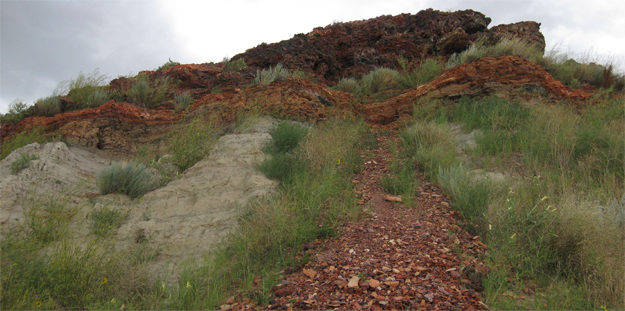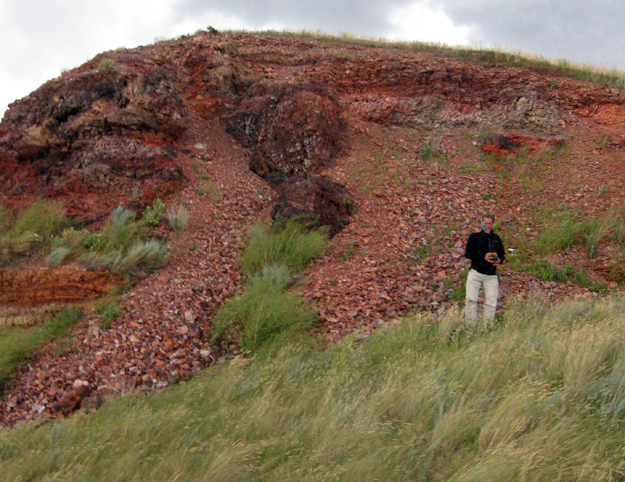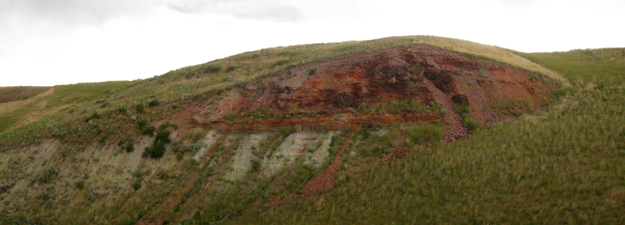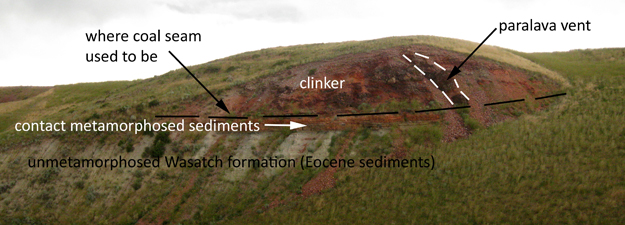Have you ever seen anything like this?

You’re looking at an outcrop of very interesting rock. The bright red stuff is officially called “clinker,” though many of the Wyoming locals where it outcrops incorrectly call it “scoria.”
What is clinker? It’s sedimentary rock that’s been baked by a burning coal seam beneath. The idea is that in places where sedimentary strata including coal outcrop on the surface, the coal seams can be set alight by prairie wildfires or lightning strikes, and then they burn back into the stratum, away from the surface outcrop (though at slower rates where there is less oxygen immediately available). The heat released by the combustion contact metamorphoses the sediments adjacent to the burning coal. This heat scorches the layers immediately below the coal to some extent, (as a lava flow will do) but most of the heat travels up, and thoroughly transforms the overlying rock. In some places, the heat may be so intense as to actually go beyond contact metamorphism, and melt the overlying sediments. When this happens, it produces a slag-like material called “paralava.” This paralava may mobilize through small vent systems that cut across the stratification of the host rock.
Here’s a more removed photo of the same outcrop, seen near Buffalo, Wyoming, on the western edge of the Powder River Basin. The strata in question are all Eocene in age, part of the Wasatch Formation. An annotated version follows, and both of these images may be enlarged with a click:
A closer look at the paralava vent (dark, sub-vertical feature) follows, with Sheridan College’s geologist Tom Johannesmeyer for scale. I think you can get a sense of the crazy wind we were experiencing as this photo was taken – strong enough that small pebbles were being picked up by the wind and slammed into us:

We were driven off the outcrop by this sudden squall: it blew up in a matter of minutes, blasting our faces with aeolian grit and then freezing rain. But not before we had collected some nice samples. One of them is now in my lab, where next semester’s Environmental Geology students will get a chance to examine it, and ponder its implications.
‘Where’s there’s clinker, there’s fire…’ or at least there was fire.



Callan,
Near VA Tech there is the Merrimac coal mine where an old spoils pile ignited due to heat from oxidizing sulfides and the rock at least partially melted. Our professor called it clinker, but maybe it should be called paralava.
We saw some really neat clinker outcrops at Teddy Roosevelt NP in North Dakota last summer–interesting info about it at this site: https://www.dmr.nd.gov/ndgs/ndnotes/ndn13_h.htm
Hi Callan, Do you have the coordinates/exact location of this clinker outcrop? Could you send them my way?
It’s roughly here:
https://maps.google.com/maps?hl=en&ll=44.334286,-106.598454&spn=0.058814,0.104628&t=h&z=14
Somewhere along the “Dump Road” outside of Buffalo, WY, the road that also goes to the Petrified Forest. I can’t spot it exactly in Google Earth, though. Sorry.
Just as long as I get the general area and the correct road I can probably find it. Dump road? Is that the actual road name or is it Co Rd. 204 in Google? If so, do you remember how far along (mileage) it was outside of Buffalo? Thanks
Or “Tipperary Road” goes to “the petrified forest site” near Buffalo if that is the forest you speak of…?
I recall it being either sign-posted or verbally referred to as “Dump Road” — I wasn’t driving, so I don’t know more than that. I think it’s the connecting road that parallels 90 for a bit before diverting and heading off towards Tipperary Road. As I recall, traffic on 90 was relatively close up the hill.
Nice post, Callan! There are numerous clinker exposures in the San Juan Basin of NW New Mexico where Cretaceous coal beds crop out. Dramatically red and black like the ones you show here. Exploration geophysicists dislike it because it scatters seismic waves. I’m told that in the bituminous belt of western Pennsylvania it’s also called “red dog.” It’s so unique that when I was teaching in NW NM I would regularly be visited by folks with specimens of clinker who were certain they were meteorites!